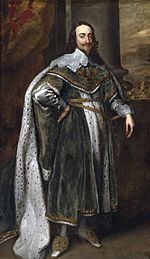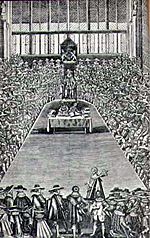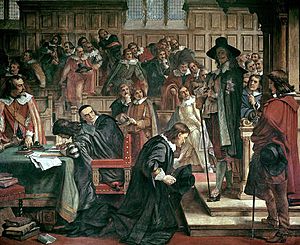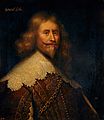English Civil War facts for kids
Quick facts for kids English Civil War |
|||||||
|---|---|---|---|---|---|---|---|
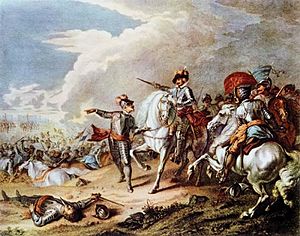 The Battle of Naseby, which was won by the Parliamentarians and ended the longest part of the war |
|||||||
|
|||||||
| Belligerents | |||||||
| Royalists | Parliamentarians | ||||||
| Commanders and leaders | |||||||
| King Charles II | Oliver Cromwell | ||||||
| Casualties and losses | |||||||
| 50,000 | 34,000 | ||||||
The English Civil War happened in the middle 17th century. A civil war is a war where people from the same country fight each other.
This war was mainly a fight between King Charles I and the Parliament of England. They disagreed on how England should be ruled. The King wanted to rule without Parliament telling him what to do. Parliament first wanted to reduce the King's power. Later, they decided England did not need a king at all.
The King's supporters were called the Royalists. They were also known as "Cavaliers". Parliament's supporters were called the Parliamentarians. They were nicknamed "Roundheads".
Fighting took place in England, Scotland, and Ireland. These were three separate countries ruled by the same king. The fighting started at different times in each country. In England, the war lasted from 1642 to 1651. Some people see this as one big war. Others see it as three separate wars. These are the First English Civil War (1642-46), the Second English Civil War (1648), and the Third English Civil War (1649-51). The wars are also sometimes called the Wars of the Three Kingdoms. This includes the Bishops' Wars in Scotland (1639-1640) and the Irish Rebellion (1641-1653).
The Parliamentarians won the war. King Charles I was captured and put on trial. In 1649, he was executed. His son, Charles II, then tried to take over. But he lost and had to escape abroad. As a result, the three kingdoms had no king for 11 years. For most of this time, Oliver Cromwell ruled. He was a former Parliamentarian general. After Cromwell died, the monarchy was restored with Charles II. However, kings were never as powerful as they had been before the war.
Why the War Started
The main reasons for the fighting were about power, money, and religion.
Power and Money Disputes
In the 1600s, the king had a lot of power in England. But there was one important rule: he could only raise taxes if the English Parliament agreed. This was because Parliament represented the gentry (middle class). No king could raise taxes without their help. Scotland and Ireland also had parliaments. But they did not have as much power.
When King James VI of Scotland became King of England (James I), he did not like working with Parliament. He was used to ruling in Scotland, where the king was much stronger. James I also spent more money than earlier kings and queens.
Both James I and his son Charles I believed in the "divine right of kings". This meant they thought God gave kings the right to do whatever they wanted. But James I accepted that he could not always get his way. Charles I, however, always wanted to get his own way.
After becoming king in 1625, Charles I quickly argued with Parliament. From 1629 to 1640, he closed Parliament down. He ruled without it. This was allowed, as long as he did not raise new taxes. He used some clever legal tricks to get money without Parliament. For example, he used "ship money". This was a tax that coastal towns paid during wartime. Charles I started charging it to all towns, even when there was no war. Many people disliked this. But judges said it was legal. The years from 1629 to 1640 were called the "Eleven Years' Tyranny" by the king's enemies.
Religious Differences
In the century before, the Protestant Reformation had brought new ideas. England had broken away from the Roman Catholic Church. In England, there was a group called the Puritans. They wanted a "pure" religion. They believed the Church of England was too much like the Catholic Church. They especially did not want the church to have bishops. A similar movement existed in Scotland. The Church of Scotland also had bishops, but it was different from the Church of England.
On the other hand, Charles I and Archbishop William Laud tried to change the Church of England. They brought back things like incense, bells, and decorations to churches. These were things found in Catholic churches. This worried people who disliked Catholicism, especially the Puritans. Charles I also married a French princess, Henrietta Maria, who was Catholic.
Events Leading to War
In 1637, Charles I tried to introduce a new prayer book in Scotland. It was very similar to the English Book of Common Prayer. He did this without asking Scotland's Parliament or church. Many Scots hated the prayer book. They saw it as an attempt to change their country's religion. Riots broke out in Edinburgh. Unrest spread throughout Scotland. A rebellion movement began in Scotland, known as the Covenanters.
In 1639, this rebellion led to the Bishops' Wars in Scotland. The war cost so much money. The King had to call a new Parliament in England to raise taxes. But the members of Parliament did not want to work with Charles. Instead, they complained about the king's actions, like ship money, during the "Eleven Years' Tyranny". He closed Parliament again. But the King struggled to stop the Covenanters without new taxes. The Covenanter army invaded England. They marched into Northumberland and County Durham. They refused to leave unless they were paid money. To get that money, the King had no choice but to call another Parliament. This became known as the "Long Parliament". More than two-thirds of its members were against the king. John Pym was their leader.
The Long Parliament passed laws to stop the king from shutting it down. They also removed many of the king's allies. They even had his friend Earl of Strafford executed. In 1641, a rebellion broke out in Ireland. This rebellion was started by Irish Catholics. They feared the Protestants in the Long Parliament and the Scottish Covenanters. The need to raise money to fight this rebellion made Parliament stronger. Parliament also took control of the army in 1642 to deal with the Irish Rebellion.
In January 1642, Charles I marched into Parliament with guards. He wanted to arrest five members of Parliament who disagreed with him. These five men found out he was coming and escaped. No king had ever entered the main chamber of Parliament before. Many members were shocked he would do this. It was a disaster for Charles. He failed to catch his enemies. Many members of Parliament who had not been against the king became afraid of him. They decided the only way to protect themselves was to raise an army against the King.
The Wars Begin
First English Civil War (1642-46)

In mid-1642, both sides started gathering supporters and weapons. On August 22, King Charles raised the royal flag in Nottingham. By doing this, he announced he was at war with Parliament.
The King found more support in the countryside. He was also supported in poorer parts of the country, and northern and western England. Parliament found more support in most cities, ports, and richer parts of the country. They were also strong in southern and eastern England. People who were secretly Catholic mostly supported the King. The Royal Navy and most Puritans supported Parliament. Some areas supported Parliament due to local issues, like land drainage projects.
The Royalist armies were led by Prince Rupert, the King's nephew. The Parliamentarian armies were first led by the Earl of Essex. The Royalists wanted to fight the Parliamentarians quickly. They went to meet them in Warwickshire. The first major battle was the Battle of Edgehill in October 1642. The battle ended in a draw. The King tried to return to London but was blocked. He moved his armies to Oxford, where he had more loyal followers.
The first year of the war went fairly well for the Royalists. They gained control over the north and west. But they were less successful in the Midlands. After mid-1643, the Parliamentarians started to do better. They won battles in Lincolnshire, in the east, and at Newbury west of London.
King Charles made a deal with the Irish rebels. This stopped the fighting in Ireland. It freed up soldiers who could fight for him. Parliament made a deal with the Scottish Covenanters, who agreed to help them. Parliament was also helped by a skilled army leader named Oliver Cromwell. He led a cavalry (horse riders) unit called the "Ironsides". The Ironsides were better organized than most cavalry units. This made them much better at fighting.

With help from the Scots and the Ironsides, Parliament won a major victory. This was the Battle of Marston Moor in July 1644. They took control of northern England. The Royalists were weaker but not yet defeated. They won the Battle of Lostwithiel in Cornwall, defeating Essex's soldiers. They also fought to a draw at a second Battle of Newbury in October.
In 1645, Parliament organized its soldiers into the New Model Army. The Earl of Essex was replaced by Sir Thomas Fairfax. Oliver Cromwell became Fairfax's second-in-command. The New Model Army was better organized than any army before it. They defeated the King's largest army at the Battle of Naseby in June 1645. Most of the Royalist soldiers at Naseby were taken prisoner. King Charles escaped Naseby but left his baggage behind. Inside were letters. The Parliamentarians opened them and found out the King was trying to get help from Irish Catholics and Catholic countries. The King lost support because of this.
The other main Royalist army was defeated at the Battle of Langport in Somerset a month later. The Parliamentarians took control of South West England, where they had been weak. King Charles tried to gather his remaining supporters in the Midlands. Many fortress towns from Oxford to Newark-on-Trent were still loyal to him. In May 1646, Charles met a Scottish army in Nottinghamshire. The Scots took him prisoner.
Second English Civil War (1648)
Even though the Parliamentarians had won, they disagreed on how to run the country. A big argument was about religion. Most members of Parliament wanted a Presbyterian national church. The New Model Army wanted to allow local churches to run themselves. They did not want a national church. The defeated Royalists supported the existing Church of England. Some were secretly Catholic. Parliament and the Army both tried to get the support of the King and the Scottish Presbyterians. King Charles was in prison. He was moved between the groups. He refused to make a deal with any of them. He believed only he had the right to rule England. He pretended to be interested in a deal while planning to take back control. The disagreements worsened when Parliament tried to break up the New Model Army.
A second war started when some Scottish Presbyterians (called the Engagers) and some English Presbyterians allied with the King. They agreed to support him if he made the English and Scottish churches Presbyterian. The Scots invaded England. Royalist rebellions broke out in different parts of England. Some rebellions were easily defeated. Stronger rebellions in Wales, Kent, Essex, and Cumberland were put down by the New Model Army. The Royalists and Scots were defeated at the Battle of Preston in August 1648.
King Charles I is Executed
The New Model Army was now in control. In an event called "Pride's Purge", army Colonel Thomas Pride removed all members of Parliament who had not supported the Army. Only about 75 members were left. The Army put them in charge of the country. This Parliament was called the Rump Parliament.
The Rump Parliament decided they would no longer work with King Charles. They put him on trial. On January 27, 1649, the trial found him guilty of treason. They called him a "tyrant, traitor, murderer and public enemy". He was killed three days later.
Many historians say that King Charles's execution was a very important moment. It was important in English history and even in the history of the Western World. No European king had ever been put on trial by his own people before. Other countries in Europe said the execution was wrong. But they did not do much else. Not all Parliamentarians supported the execution. Fairfax thought it was wrong. He resigned as leader of the New Model Army. Oliver Cromwell replaced him.
The next king would have been Charles's son, Prince Charles. He would become King Charles II. But Parliament announced that England would become a republic. It was called the Commonwealth of England. However, Prince Charles could still become King of Scotland.
Third English Civil War (1649-51)
The third English Civil War was mostly a fight between Scottish and English armies. Much of it was fought in Scotland.
In 1649, the Marquess of Montrose started a rebellion in Scotland. He supported King Charles II. But Charles decided to ally with the Scottish Covenanters instead of Montrose. The Covenanters feared the Commonwealth of England would stop Scotland from having a Presbyterian church. Montrose was defeated by Scottish armies in April 1650. In June, Charles landed in Scotland. He signed an agreement with the Scottish Covenanters.
Cromwell traveled to Scotland and arrived the next month. Over the next year, he took control of the main parts of Scotland. When Charles fled to England, Cromwell followed him. He left George Monck to finish winning the war in Scotland. When this was done, Scotland became part of the Commonwealth of England.
Charles's army marched across England. They went to the western regions where Royalists had the most support. However, they could not find as many supporters as they wanted. Cromwell found them and defeated them at the Battle of Worcester on September 3, 1651. Charles fled to The Netherlands. He would not return until 1660.
Irish Rebellion
The Irish rebellion started in 1641 and continued until 1652. It was mainly fought by Irish Catholics. They fought against armies of the English Parliamentarians, Scottish Covenanters, and Protestant settlers in Ireland. At first, the rebels also fought English Royalist armies. But this mostly stopped after September 1843. Seven months after the rebellion began, the rebels created their own government in Kilkenny. This was known as the Irish Catholic Confederation.
In 1649, Oliver Cromwell went to Ireland. He put down their rebellion. Cromwell was remembered in Ireland as a very harsh invader. This was especially because of the large numbers of people killed at the Siege of Drogheda. Some fighting continued in Ireland until 1653.
After the War
The Next Nine Years (1649-1660)
The wars left England, Scotland, and Ireland as part of the Commonwealth of England. It was one of the few countries in Europe without a king. After the wars ended, Cromwell closed the Rump Parliament. He took over the country. He chose to be "Lord Protector" instead of King. He did not think the country needed another king. His government was called "the Protectorate" or "the Commonwealth". The time from 1649 to 1660 is also called the English Interregnum. This means a gap between kings.
Oliver Cromwell ruled the country until he died in 1658. Cromwell's son, Richard, became Lord Protector. However, the Army did not think he was a good ruler. After seven months, the Army removed Richard. In May 1659, they brought back the Rump Parliament. But the Army did not get along with the Rump Parliament either. They closed it down a second time. People feared England would not have a proper government.
George Monck, a key Army leader, arranged for a new Parliament to be elected. On May 8, 1660, the new Parliament decided to bring back the monarchy. Charles II became king. He returned to England later that month. This event is known as the English Restoration. Scotland and Ireland went back to being separate countries. The churches that existed before the war also returned.
Long-Term Effects
Even though the monarchy returned, the Civil War had lasting effects. The war made it clear that an English king could not rule without Parliament's support. The law was not changed right away to limit the king's power. This happened after the 1688 Glorious Revolution. But historians see the Civil War as a step in England and Scotland's journey. They moved from rule by one king to becoming a democracy.
In Ireland, the defeat of the rebellion made the Protestants more powerful. This was one reason why Ireland was ruled by Protestants from the late 1600s until the 1900s. This was true even though most Irish people were Catholic.
War Tactics
The English Civil War was fought using "pike and shot" tactics. These tactics were common in most wars from the late 1400s to the late 1600s. Armies were divided into three main groups:
- Musketeers: They fired a type of gun called a musket. Muskets were not as powerful or easy to use as modern guns.
- Pikemen: They carried a very long spear, called a pike. Their main job was to stop the enemy's cavalry.
- Cavalry: They were horse riders who would charge at the enemy's musketeers. A very skilled cavalry could even charge at the enemy's pikemen.
At first, the Royalists had better cavalry. Their riders were faster and more skilled. Prince Rupert had fought in the Eighty Years' War in The Netherlands. He used what he learned there to improve his cavalry. However, sometimes the Royalist cavalry did not work well as a team. At the Battle of Edgehill, many of them chased fleeing soldiers. Or they stole from the Parliamentarian baggage wagons. The Royalists might have won this battle if their cavalry had stayed together.
Cromwell's "Ironside" cavalry were slower. But they worked better as a team. They helped the Parliamentarians win some key battles. The Parliamentarians sometimes had a problem. Their pikemen would run away when cavalry charged at them. Cromwell and Fairfax trained them to stay in place.
Images for kids
-
Henrietta Maria, painted by Peter Lely, 1660
-
Alexander Leslie, 1st Earl of Leven, Lord General of the Covenanter Army and one of the victors of Marston Moor
See also
 In Spanish: Revolución inglesa para niños
In Spanish: Revolución inglesa para niños


